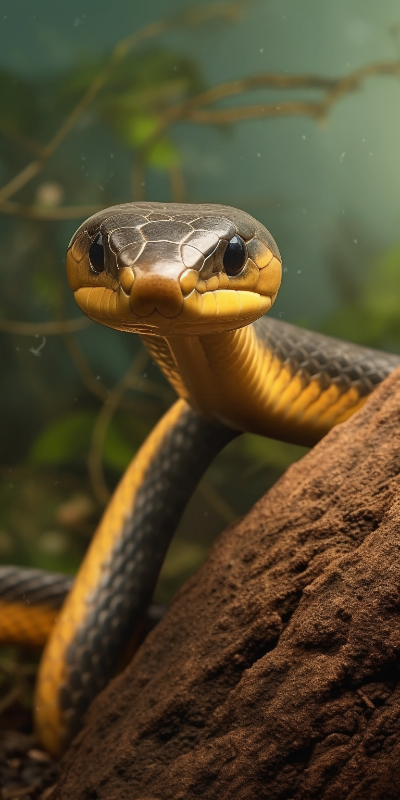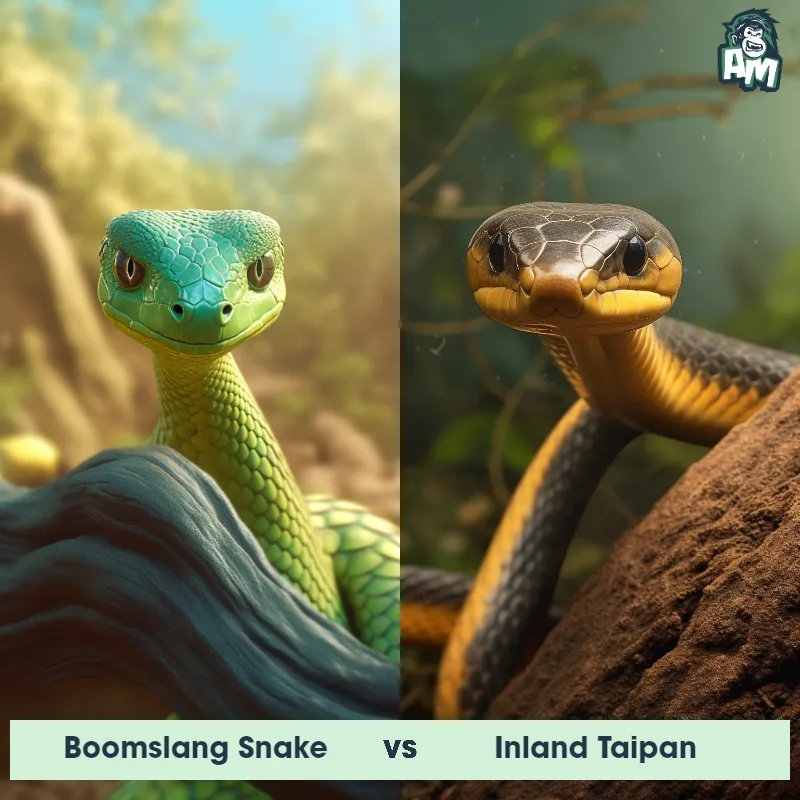The Inland Taipan
The Inland Taipan, also known as the "fierce snake," is considered the most venomous snake in the world. It is a highly secretive and extremely dangerous snake found in the arid regions of Australia. With a slender body and smooth scales, the Inland Taipan can reach lengths of up to six feet. Its coloration varies from dark brown to light olive, blending perfectly with its surroundings. This venomous snake is known for its potent neurotoxic venom, which can cause rapid paralysis and potentially fatal consequences to its prey or a human if bitten.

| Inland Taipan | |
|---|---|
| Size | Up to 8 feet (2.5 meters) |
| Weight | Up to 5 pounds (2.3 kilograms) |
| Speed | Speed: 12.4 mph (20 km/hr) |
| Key Strength | Venomous bite |
| Biggest Weakness | Shy and reclusive nature |
| Scientific Name | Oxyuranus microlepidotus |
| Family | Elapidae |
| Habitat | Arid regions |
| Geography | Australia |
| Diet | Small mammals, such as rats and mice |
| Lifespan | 10 years - 15 years |

The Inland Taipan
The Inland Taipan, also known as the "fierce snake," is considered the most venomous snake in the world. It is a highly secretive and extremely dangerous snake found in the arid regions of Australia. With a slender body and smooth scales, the Inland Taipan can reach lengths of up to six feet. Its coloration varies from dark brown to light olive, blending perfectly with its surroundings. This venomous snake is known for its potent neurotoxic venom, which can cause rapid paralysis and potentially fatal consequences to its prey or a human if bitten.
Fun Fact: The Inland Taipan has the ability to deliver multiple and distinctly different bites with a single strike by flexing its fangs independently, which is quite unique among venomous snakes.
| Inland Taipan | |
|---|---|
| Size | Up to 8 feet (2.5 meters) |
| Weight | Up to 5 pounds (2.3 kilograms) |
| Speed | Speed: 12.4 mph (20 km/hr) |
| Key Strength | Venomous bite |
| Biggest Weakness | Shy and reclusive nature |
| Scientific Name | Oxyuranus microlepidotus |
| Family | Elapidae |
| Habitat | Arid regions |
| Geography | Australia |
| Diet | Small mammals, such as rats and mice |
| Lifespan | 10 years - 15 years |
Inland Taipan Matchups
We use AI to simulate matchups between the Inland Taipan and other animals. Our simulation considers size, strength, and natural predatory behaviors to determine the most likely outcome.
Inland Taipan: Diet, Predators, Aggression, and Defensive Behaviors
What do Inland Taipans eat?
Inland Taipans primarily feed on small mammals, particularly rodents like rats and mice. They are highly skilled hunters that use their excellent sense of smell and vision to locate prey in their arid desert habitats.
Do Inland Taipans have any predators?
As adults, Inland Taipans have very few natural predators due to their potent venom. However, they may still fall victim to large birds of prey, such as eagles, that are able to swoop down and grab them before they can defend themselves.
Are Inland Taipans aggressive?
Inland Taipans are not inherently aggressive snakes and will generally avoid confrontation if possible. They are reclusive and shy animals that will only strike as a last resort when threatened or cornered.
Do Inland Taipans fight?
Inland Taipans do not engage in fights with other snakes or animals unless it is a matter of self-defense. They will use their venomous bite as a means of protection rather than engaging in physical combat.
How do Inland Taipans defend themselves?
Inland Taipans rely on their potent venom as their primary defense mechanism. When threatened, they will deliver a series of rapid, accurate bites that inject a neurotoxic venom into their attacker, incapacitating them quickly.
What is the biggest weakness of Inland Taipans in a fight?
Despite their deadly venom, Inland Taipans are relatively docile and may hesitate to strike if they feel threatened. This hesitation can be a weakness in a fight, as it may give their opponent an opportunity to strike first or escape before being bitten.
Fun Fact: Despite its reputation as an incredibly venomous snake, the Inland Taipan is relatively shy and avoids confrontation with humans and other animals whenever possible.
Fun Fact: The venom of the Inland Taipan is so potent that just one bite contains enough toxins to kill up to 100 fully grown men or approximately 250,000 mice. Fortunately, effective antivenom exists, and no human deaths have been recorded since its development.


















